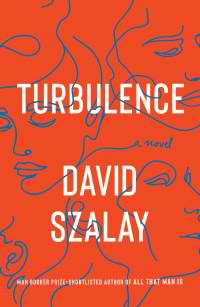Turbulence by David Szalay
 Wednesday, July 17, 2019 at 8:50AM
Wednesday, July 17, 2019 at 8:50AM 
Published by Scribner on July 16, 2019
A woman who becomes ill on a flight from London to Madrid hopes that the life of a man who has cancer will be spared in exchange for her death. A man sitting next to her spills a Coke on his trousers. From Madrid, that man flies home to Dakar. After witnessing the death of a child in a traffic accident, a pilot flies from Dakar to São Paulo, wondering whether his girlfriend in Frankfurt is alone.
Turbulence is a series of connected stories, each beginning with a flight from the city in which the preceding story was set and taking place in the destination city. As the characters jet from one city to another, they encounter the turbulence of life. A mother does not know how to respond when her daughter’s baby is born blind. A married senior tells her husband that she is in love with another man, causing their life to proceed “outwardly as normal for a while after that, though with a kind of silence at the heart of it.” A debt between friends sparks an argument, although the lender’s anger can be traced to an unrelated circumstance described in an earlier story. A woman’s husband flies home to abuse her, then flies back to Qatar where he is living a secret life.
The story about the married woman in her sixties who has an affair is my favorite. She loved her husband intensely once and knows that the intense love she feels for the new man will fade, just as her intense love for her husband did, but she surrenders to it anyway. Falling in love again somehow makes her marriage seem untrue, and she “did not want to live with something untrue.” The question is whether she should abandon her husband or work with him to restore truth to their marriage.
The novel is one of relentless motion; the stories are fleeting. Taken together, the overlapping chapters illustrate how people around the world make connections with each other, sometimes unnoticed or quickly forgotten as they move on to their next destination. The novel also emphasizes the similarities of people around the world. A troubled marriage in India echoes another in Hong Kong. Tensions between a parent and child in Budapest echo a relationship in Madrid. The man who lives multiple lives in India and Qatar sparks concern that a man who is about to marry in Budapest has another life in Syria.
David Szalay writes with surgical precision about the darkness that so often betrays the better self. Most books about connections focus on love, childbirth, and the other joys that bind humanity. Yet it is also true that humans everywhere face the same fears and burdens: death, duplicity, the exposure of embarrassing secrets. Turbulence is not a life-affirming novel — its bleakness may put off some readers — but Szalay offers an honest glimpse of the trauma and despair that people of all social classes, races, ages, and nationalities share in all parts of the world.
RECOMMENDED



